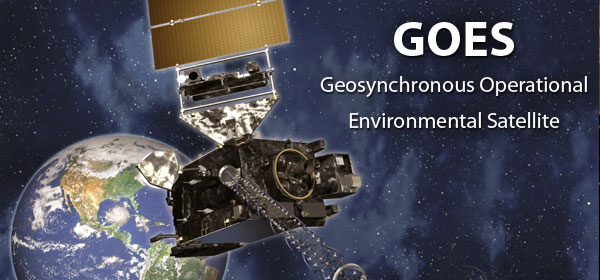GOES
Geosynchronous Operational Environmental Satellite
The National Oceanic and Atmospheric Administration (NOAA) operates a series of meteorology observing satellites that is a continuation of the Synchronous Meteorological Satellite (SMS) series.
 This GOES program formally began in 1975 with the launch of the first operational spacecraft, GOES-A, renamed GOES-1 when it reached orbit.
This GOES program formally began in 1975 with the launch of the first operational spacecraft, GOES-A, renamed GOES-1 when it reached orbit.
The GOES spacecraft circle the Earth in a geosynchronous orbit, which means they orbit close to the equatorial plane of the Earth at a speed matching the Earth’s rotation. This allows them to appear to hover continuously over one position on the surface of the Earth at an altitude of 35,800 km (22,300 miles).
In addition to providing systematic, continuous observations of terrestrial weather, GOES also provides observations of space weather through its Space Environment Monitor (SEM) system. The three main components of space weather monitored by GOES are: X-rays, energetic particles, and the magnetic field. The initial series of satellites maintained attitude control by spinning. This is known as “spin-stabilized.” With the advent of GOES-8, launched in 1995, the basic platform design became “3-axis stabilized.” In 2001 GOES-12 was launched with a new X-ray instrument onboard — the Solar X-ray Imager (SXI)**. This instrument creates images of the Sun, whereas the original XRS instrument only generated whole disk flux measurements.

- X-ray Sensor (XRS) is an ion chamber that provides whole-Sun X-ray fluxes in the 0.5-to-4 and 1-to-8 Angstrom (Å) wavelength bands. These observations provide a sensitive means of detecting the start and evolution of solar flares. Two bands are measured to allow the hardness of the solar spectrum to be estimated and hence also the temperature and emission measure of the emitting hot flare plasma.
- Energetic Particle Sensor (EPS) is a solid-state detector with pulse-height discrimination to measure proton, alpha-particle, and electron fluxes.
- Magnetometer is a twin-fluxgate spinning sensor that provides measures of three mutually perpendicular components of the Earth’s magnetic field.
- Soft X-ray Imager (SXI) (only on GOES-12 and 13) provides a continuous sequence of full-Sun X-ray images at a 1-minute cadence with a 512×512 intensified CCD. Broadband filters are employed to obtain images in several wavelength bands between about 6 and 60 Å.
| Launch Date | Status | ||
| GOES-1 (A) | October 16, 1975 | Decommissioned | |
| GOES-2 (B) | June 16, 1977 | Decommissioned | |
| GOES-3 (C) | June 16, 1978 | Decommissioned | |
| GOES-4 (D) | September 9, 1980 | Decommissioned | |
| GOES-5 (E) | May 22, 1981 | Decommissioned | |
| GOES-6 (F) | April 28, 1983 | Decommissioned | |
| GOES-G | May 3, 1986 | Failed* | |
| GOES-7 (H) | February 26, 1987 | Decommissioned | |
| GOES-8 (I) | April 13, 1994 | Decommissioned | |
| GOES-9 (J) | May 23, 1995 | Decommissioned | |
| GOES-10 (K) | April 25, 1997 | In Operation | |
| GOES-11 (L) | May 3, 2000 | In Operation | |
| GOES-12 (M) | July 23, 2001 | In Operation** | |
| GOES-13 (N) | May 24, 2006 | In Orbit Storage*** | |
| GOES-O | November 5, 2008 | ||
| GOES-P | 2010 | ||
| GOES-Q | Cancelled | ||
| GOES-R | 2014 |
* GOES-G failed to make it into orbit when its Delta rocket lost control after being struck by lightening shortly after liftoff.
**The SXI instrument is out of commission indefinitely due to a GOES 12 X-ray Sensor (XRS) anomaly on April 12, 2007.
***No GOES 13 SXI images are available after December 2006 due to a detector anomaly that occurred in conjunction with an X-class flare.
In addition to monitoring weather on Earth, the GOES-R satellites will monitor weather in space caused by electromagnetic radiation and charged particles released from solar storms on the Sun. Many people rely on space weather data, including pilots, farmers, satellite operators, electric power workers, and astronauts.
CREDIT: NASA Goddard

